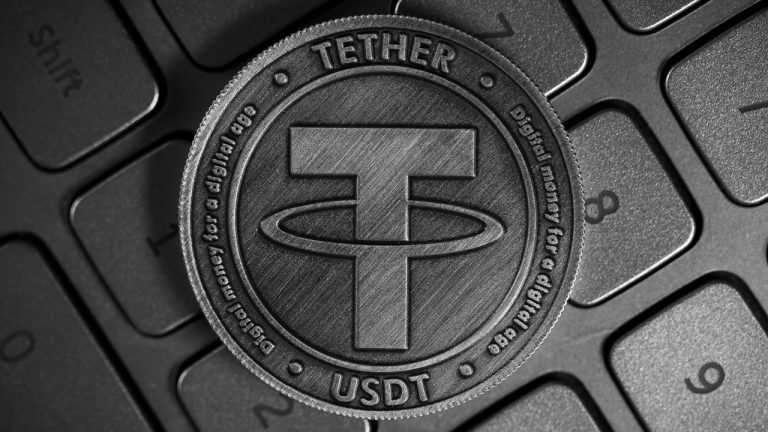 The World Economic Forum (WEF) has reviewed what happened in 2022 in crypto, making several predictions about the future of the ecosystem. Dante Disparte, CSO of Circle, in an article published for the WEF, states that while 2022 has been a terrible year, the building blocks of the industry will continue to be “integral parts” […]
The World Economic Forum (WEF) has reviewed what happened in 2022 in crypto, making several predictions about the future of the ecosystem. Dante Disparte, CSO of Circle, in an article published for the WEF, states that while 2022 has been a terrible year, the building blocks of the industry will continue to be “integral parts” […]
Turmoil in the crypto sector in 2022 will see the tech change hands to "more regulated and established institutions," said Circle's chief strategy officer.
Circle's chief strategy officer and head of global policy, Dante Disparte, believes that the turmoil in the crypto sector over the last year could mark the handover of crypto technology to more durable companies and "steadier hands" in 2023.
In a Jan. 2 post for The World Economic Forum (WEF), Disparte highlighted the growing use of crypto in the financial services sector and opined that the ongoing bear market and exchange collapses may ultimately be a boon for the industry, paving the way for "responsible, always-on internet finance."
"Just as it took the dot-com bubble bursting in the early 2000s to hand over the future of the internet to more durable companies, business models and use cases, perhaps 2022 marks a handover of crypto technology and blockchain infrastructure to steadier hands," he said.
Disparte was giving his opinion via his position at Circle, the issuer of U.S.-dollar pegged stablecoin USD Coin (USDC). He also serves on the World Economic Forum's Digital Currency Governance Consortium and is a life member of the Council on Foreign Relations.
Happy New Year! Following an annus horribilis for #Crypto in 2022, now more than ever demonstrable utility value is the order of the day. Sharing my @wef #WEF23 reflections on what the future holds and how @circle is navigating turbulence. https://t.co/emR4cHNbu3
— Dante Disparte (@ddisparte) January 2, 2023
In the blog post, Disparte also added that cryptography and blockchain will continue to be an “integral” part of the “modern economic toolkit,” despite the “terrible year” for crypto — which he said was more akin to a crypto "ice age" than winter.
2022 turned into a very bumpy year for the crypto market, with one of the worst bear markets on record and the collapse of some major platforms within the space.
However, Disparte said despite these setbacks, mainstream financial services will still look to crypto at some point because "the technology remains a protagonist in the global financial world."
"Indeed, as a test of the staying power of digital assets and blockchains at the core of financial services (and other areas of the global economy), watch what the big banks and mature financial services firms do, not what they say," Disparte added.
The end of Bitcoin (BTC) has now been announced more than 460 times, according to the Bitcoin Obituaries Archive, and despite some high-profile resistance from mainstream financial services, some of the most outspoken critics have begun wading into the crypto waters.
Related: 13% of Americans have now held crypto: JPMorgan research
Disparte doubled down on his stance in a Jan. 2 opinion piece for the Diplomatic Courier, calling it "disingenuous" for bankers to criticize crypto with one hand while trying to co-opt its innovations on the other.
"To link all crypto innovations, the responsible and the irredeemable together would be like dismissing all banking because of Danske Bank's $230 billion money laundering pipeline," he argued.

USDC is a U.S. dollar-backed stablecoin issued by Circle and Coinbase to combat the price swings of the highly volatile cryptocurrency market.
Despite the fact that the USD Coin is subject to regulatory oversight, investors must weigh the pros and cons of investing in stablecoins before committing any funds.
Comparing USDC with USDT, USDC is subject to regulations as it is audited from time to time, and Circle is fully transparent about its operations. However, investing in the cryptocurrency market, even in stablecoins, has its own cons. For instance, the price of the USD Coin will never appreciate as it is pegged to the U.S. dollar.
This disadvantage is offset by the provision that USDC can be lent and borrowed on decentralized platforms to earn passive income. Moreover, it depends upon one’s risk-return profile and how much funds one wants to allocate to a particular asset. Also, with trusted exchanges like FTX going bankrupt, one must be mindful of the risks of investing in stablecoins and cryptocurrencies.
Although both USDC and USDT are USD-backed stablecoins, they have some differences in terms of the year they were launched, issuing organizations, compatibility with blockchain networks, assets-backing and auditors.
USDC and USDT are fiat-collateralized stablecoins pegged to the U.S. dollar, which were introduced to combat the highly volatile price swings of the cryptocurrency market. The majority of significant cryptocurrency exchanges offer USDC.
Similar to USDT, USD Coin can be sent and received by any ERC-20 compliant wallet or exchange and other blockchains like Stellar, Algorand, Solana and more. Along with these similarities, significant variations between these two stablecoins could influence a user’s choice.
Here are a few differences between USDC and USDT stablecoins:

USD Coin can be bought on cryptocurrency exchanges after meeting the Know Your Customer requirements.
One can buy USDC on exchanges like Coinbase, Kraken and Gemini. For example, buying USD Coin on a centralized exchange like Coinbase involves the following steps:
USDC offers instant payments, saves users from the cryptocurrency market’s price volatility and is audited by a regulated auditing firm, making it a transparent stablecoin. However, it does not offer price appreciation opportunities, and investors may incur high transaction and withdrawal fees while dealing with USDC.
One of the key advantages of the USD Coin is the speed of the transaction. Usually, one must wait a long time to send and receive USD because institutions such as banks and their complex procedures slow down the processing of transactions. Nonetheless, USDC allows instant clearing and settlement of payments.
In addition, stablecoins like USDC saves users from the price volatility of cryptocurrencies, as leading American financial institutions ensure that Circle’s reserves are 100% backed by the U.S. dollar or short-term treasuries at all times. Moreover, there are numerous digital asset exchanges where one may buy USDC. Many exchanges also enable the withdrawal of USDC across various blockchains.
Furthermore, using a cryptocurrency wallet, one can quickly make cross-border payments or remittances. Similarly, one can earn passive income by lending USDC on decentralized finance (DeFi) platforms like Aave.
Regardless of the above advantages, the USD Coin may not be an ideal investment asset for those looking to earn money from digital assets because USDC may not offer potential price appreciation opportunities to yield profits.
Also, some exchanges charge a high fee for withdrawing USDC stablecoin, and transaction fees may be higher than a typical bank transfer or a PayPal transfer for smaller transactions. Moreover, even if DeFi platforms offer more interest for each USDC lent, they are riskier, as evidenced by various crypto heists.
A USD Coin is a fully transparent and audited stablecoin, which is pegged to the U.S. dollar and can be used for instant global payments, purchasing goods and services and lending and borrowing without intervention of third parties.
The USD Coin maintains the same value as the U.S. dollar, making it a unique option for holding a digital currency without bearing the price risk of major cryptocurrencies such as Bitcoin (BTC) and Ether (ETH). Other notable features of the USD Coin are explained below:
Each time a USD is deposited, a smart contract creates a USDC that may be redeemed for one dollar.
USDC commercial issuers must possess any or all licenses required by the operating jurisdictions. Moreover, they need to ensure audited Anti-Money Laundering and compliance processes that comply with the Financial Action Task Force requirements.
They should support the fungible exchange and redemption of USDC tokens from other reputable issuers and abide by further reporting and review specifications set forth by the Center. USDC issuers must also hold reserves at a 1:1 ratio to the amount of issued tokens and offer monthly publicized proof of reserves with qualified public auditors’ attestations.
Technically, a USDC token is created via a smart contract each time a dollar is deposited. Moreover, each USD Coin is redeemable for one dollar and is backed by either one dollar or an asset denominated in USD (fiat currency), which is kept in accounts at regulated institutions in the United States.
For stablecoins and USDC to function as intended, the parties in charge of overseeing them must be trustworthy and transparent. As a result, Circle employs Grant Thornton LLP, a U.S. accounting company, to audit those accounts and offer routine updates via monthly attestations on the reserves supporting USDC.
Then, to maintain consistent backing, the coins are permanently destroyed, or burned, when a consumer wants to redeem USDC back for dollars, and funds from the underlying reserves are returned to the client’s external bank.
A fully-reserved stablecoin, USDC, was created to ensure price parity with the US dollar.
USD Coin (USDC) is a fiat-collateralized stablecoin, a decentralized digital asset that lives on the blockchain and is pegged to a fiat currency — in this case, the United States dollar — to stabilize its value against market volatility. However, USDC is not the only stablecoin available in the market. Another asset-backed (U.S. dollar) stablecoin called Tether (USDT) was launched in 2014 by Tether Limited.
So who is behind the USD Coin? The Boston-based Circle and Coinbase exchange created the USD currency (USDC) in 2018 as part of the Center consortium. USD Coin claims to be equivalent in value to one U.S. dollar, meaning that for every USDC in circulation, one U.S. dollar is held in reserve. In essence, the USD Coin is a service that tokenizes the U.S. dollar and makes it easier to utilize over the internet and on public blockchains.
Unlike cryptocurrencies, the USD Coin cannot be minted. USDC is available as ERC-20, the most widely used standard for blockchain apps, making it interoperable with all other Ethereum-based decentralized applications (DApps). However, it is not solely restricted to the Ethereum network. Instead, the USD Coin is compatible with significant blockchain networks, including Solana, Stellar, Algorand, Flow and TRON.
Since its introduction, USDC has established itself as a critical component of the stablecoin market with ample liquidity and trading across centralized and decentralized exchanges worldwide.

While on-chain stablecoins settlements are growing rapidly, many people pointed out that comparing stablecoin settlements to Visa transactions is not fair as they represent two different things.
Stablecoins play a very critical role in the crypto economy today and despite the recent run-down in the broader market, stablecoin volumes continue to dominate most exchanges.
According to Coinmetrics data, on-chain stablecoin settlements reached over $7 trillion in 2022 and are expected to end the year at around $8 trillion. While the largest card network, Visa, processes ~$12tn/yr.
Peter Johnson, co-head of the venture at Brevan Howard Digital, said that stablecoin settlements had already surpassed MasterCard and American Express. Furthermore, he predicted that in 2023 on-chain stablecoin volumes will surpass the Visa transaction volumes.
He also noted that stablecoins volume would not only surpass Visa but most likely surpass the aggregate volume of all four major card networks (Visa, Mastercard, AmEx, and Discover). Johnson added that these on-chain stablecoin volumes don't include a trading volume on centralized exchanges which has a significant chunk of its own.
3/ (Note that this is just on-chain settlement volume, and does not include trading volume on centralized exchanges)
— Peter Johnson (@TheChicagoVC) December 21, 2022
While the comparison definitely indicates a significant increase in stablecoin usage, many users pointed out that the comparison between the two entities doesn’t hold ground as they are two different things.
Related: Stablecoin regulations in the US: A beginner’s guide
There is a distinction to be made between credit card volumes and stablecoin settlements. Credit card transactions are typically associated with consumer spending, whereas fiat-pegged crypto assets are primarily associated with crypto trading and decentralized finance.
Hmm kinda comparing apples and oranges. Mastercard/discover etc volumes are sourced from consumer spending. Onchain volume is sourced from investor speculation.
— Kim ⚡️ (@0xKimberly) December 21, 2022
This $7+tn would need to come from payments for consumer goods/services using stablecoins to be a relevant comparison
A key barrier for stablecoins to be actively used by consumers in their daily lives just like Visa and Mastercard is regulations. However, Republican Senator Pat Toomey, who is set to retire from U.S. Congress at the end of the term, aims to change that with his stablecoin bill. The bill proposes to permit non-state and non-bank institutions to issue stablecoins, as long as they obtain a federal license created and issued by the U.S. Office of the Comptroller of the Currency (OCC), and as backed up by “high-quality liquid assets.”
In terms of market capitalization, stablecoins currently make up about 16.5% of the total. CoinGecko data indicates that the value of all of the stablecoins together is about $140 billion. Tether-issued USDT currently dominates the stablecoin market with a total supply of 66.3 billion USDT followed by Circle’s USDC with a 44.3 billion in UDSC market supply.

Coinbase’s request comes just a couple of months after Binance ceased support for USDC.
United States-based cryptocurrency exchange Coinbase has asked its customers to convert their Tether-issued USDT (USDT) stablecoin to USD Coin (USDC), a USD-pegged stablecoin issued by Circle and co-founded by Coinbase in 2018.
The cryptocurrency exchange suggested that USDC is a much more secure alternative in the wake of the FTX collapse saga and has also exempted any fee on the conversion of USDT to USDC on its platform. The firm said:
“We believe that USD Coin (USDC) is a trusted and reputable stablecoin, so we’re making it more frictionless to switch: starting today, we’re waiving fees for global retail customers to convert USDT to USDC."
Stablecoins started out as an onboarding tool for the crypto exchanges in the early days of crypto, but today they have become a key market player and liquidity source. However, there has always been some form of scrutiny around their reserves backing these stablecoins. A stablecoin, by definition, must be backed by 1 USD or equivalent.
The reserve debate intensified in the aftermath of FTX collapse as many firms with exposure to the tainted exchange and its sister company Alameda Research went bankrupt. There was another allegation about Binance CEO Changepeng Zhao trading barbs with former FTX CEO Sam Bankman-Fried and accusing him of trying to depeg USDT.
post-strike FTX scoop: Just before the bankruptcy, @cz_binance accused @SBF_FTX of trying to drive down the price of Tether. They traded barbs in a group chat with other crypto execs. “The more damage you do now, the more jail time," CZ said. https://t.co/OTlYgoEruJ
— David Yaffe-Bellany (@yaffebellany) December 9, 2022
Tether published its latest quarterly attestation on Nov. 10, just a day before the exchange filed for bankruptcy. The report noted that 82% of Tether’s reserves are held in cash, cash equivalents and other short-term deposits as of Sept. 30, 2022.
Coinbase also stressed that USDC is 100% backed by “cash and short-dated U.S. treasuries held in U.S. regulated financial institutions,” and it is always redeemable 1:1 for U.S. dollars.
Related: Circle co-founder says converged dollar books on Binance would be good for USDC
Apart from the debate over reserve audits, there is a growing “stablecoin war” among crypto exchanges as well. Coinbase’s request to convert USDT to USDC comes just a couple of months after Binance, another global player, cut support for USDC leading to a drop of $3 billion in the market cap of the Coinbase co-founded stablecoin.
Tether-issued USDT is the largest stablecoin by market share with a market cap of $65 billion, USDC currently sits at a $42 billion market capitalization but has rapidly eaten into USDT’s market share. Binance’s stablecoin, BUSD, currently has a market cap of $22 billion.
Tether didn’t respond to Cointelegraph’s requests for comments at press time.
 Over the last few weeks, there’s been a lot of information revealed surrounding the recent FTX and Alameda Research disaster. On Dec. 6, the Financial Times (FT) published documentation that shows Alameda’s investment portfolio, which alleges the company spent more than $5 billion on hundreds of investments. Some of the funds went to odd investments […]
Over the last few weeks, there’s been a lot of information revealed surrounding the recent FTX and Alameda Research disaster. On Dec. 6, the Financial Times (FT) published documentation that shows Alameda’s investment portfolio, which alleges the company spent more than $5 billion on hundreds of investments. Some of the funds went to odd investments […]
The firm behind the second largest stablecoin by market cap is backing out of a multi-billion dollar deal to go public. According to an official announcement, Circle and Concord Acquisition Corp are mutually terminating a proposed business deal between the two groups. Concord Acquisition Corp is a publicly traded special purpose acquisition company. Says Concord […]
The post USDC Issuer Circle Calls Off $9,000,000,000 Deal To Go Public: Report appeared first on The Daily Hodl.

The deal previously valued Circle at $4.5 billion in July 2021 before an upwards revision to $9 billion in February 2022.
According to a new press release published on Dec. 5, USD Coin (USDC) issuer Circle announced the mutual termination of its proposed merger with special purpose acquisition company, or SPAC, Concord Acquisition. The deal was announced in July 2021 with a preliminary valuation of $4.5 billion and was then amended in February 2022 when Circle's valuation ballooned to $9 billion. USDC is currently the second largest stablecoin in circulation, with a market cap of $43 billion.
Under the terms of the agreements, Concord had until Dec. 10 to consummate the transaction or seek a shareholder vote for an extension. However, it appears that Concord chose to have the time limit lapse instead. As told by Circle CEO Jeremy Allaire:
"Concord has been a strong partner and has added value throughout this process, and we will continue to benefit from the advice and support of Bob Diamond and the broader Concord team. We are disappointed the proposed transaction timed out; however, becoming a public company remains part of Circle's core strategy to enhance trust and transparency, which has never been more important."
Circle further reiterated that it "became profitable in the third quarter of 2022, with total revenue and reserve interest income of $274 million and net income of $43 million." The company currently has $400 million in unrestricted cash.
While the stakeholders didn't directly state the reason behind the deal's fallout, the ongoing crypto winter has led to a spiral of downward revisions for many companies' valuations. On top of that, SPAC mergers have also performed poorly, with the IPOX SPAC index benchmark falling over 40% since reaching all-time highs in February 2021. Likewise, Israeli cryptocurrency exchange eToro terminated its $10 billion SPAC merger this July after a downward revision to its valuation.
 Since people are once again talking about self-custody as one of crypto’s unique strengths, I would like to remind everyone about an equally important fundamental value proposition of crypto that, in the early days, was touted as the killer feature. I’m talking about censorship resistance. The following opinion editorial was written by Bitcoin.com CEO Dennis […]
Since people are once again talking about self-custody as one of crypto’s unique strengths, I would like to remind everyone about an equally important fundamental value proposition of crypto that, in the early days, was touted as the killer feature. I’m talking about censorship resistance. The following opinion editorial was written by Bitcoin.com CEO Dennis […] During the last month, the market capitalization of all the stablecoins in existence dropped by more than 2%, shedding roughly $2.98 billion since the end of October. Statistics show that tether, the largest stablecoin by market valuation, saw its market cap lose more than 5% during the last 30 days. Tether’s market cap slipped from […]
During the last month, the market capitalization of all the stablecoins in existence dropped by more than 2%, shedding roughly $2.98 billion since the end of October. Statistics show that tether, the largest stablecoin by market valuation, saw its market cap lose more than 5% during the last 30 days. Tether’s market cap slipped from […]